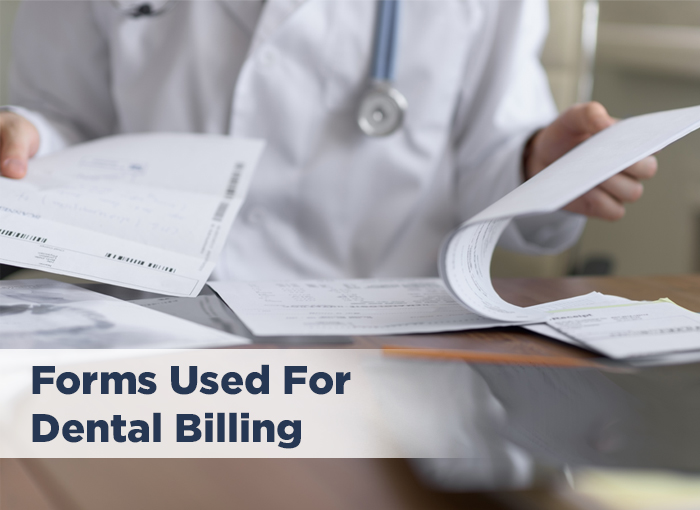Dental billing is one of the most essential parts of revenue cycle management (RCM). The process requires submitting a clean claim in order to get reimbursement of the rendered dental services from the insurance companies. In general, dental claims are submitted by filling ADA dental claim forms. This claim form is made on the guidelines laid out by American Dental Association (ADA) and keeps on updating periodically. In a few cases, CMS-1500 (medical billing form) can also be used to file dental claims.
ADA Dental Claim Form
ADA dental claim forms incorporate HIPAA standards for electronic dental claim transactions.
General Guidelines:
- The name and address of the payer (insurance companies or dental benefit plan) should be mentioned in the standard #9 window envelope.
- Every detail is mandatory unless marked otherwise on the form or CDT manual.
- The full name of the individual has to be mentioned on the form wherever required.
- The full name of the business along with the address and zip code has to be mentioned wherever required.
- The years in the mentioned date should be of four digits.
- If the number of rendered procedures cannot be contained within the given number of lines in the form, a separate form has to be filled with all the details.
- COB (Coordination of Benefits): Dental claims submitted to the secondary payer should include EOB (Explanation of Benefits) to show the reimbursed amount by the primary payer. The same amount has to be filled in the “Remarks” field. CDT manual contains detailed instructions for the completion of the same.
- Diagnosis Code: Diagnosis codes are required for claim adjudication when certain treatment is required to reduce the risk of a patient’s oral and systemic health conditions. Up to four diagnosis codes can be used for each procedure.
- Place of Treatment: As per HIPAA standards, a 2-digit code is used for a professional claim. You can find the full list of these codes on www.cms.gov
- Provider Specialty: Different types of dental professionals have a specific code based on their specialty. Additionally, a general code for the dentist can be used in the form as well. The codes can be found at https://www.ada.org/en/publications/cdt/ada-dental-claim-form
- The claim can be submitted for services rendered, pre-determination, pre-authorization, or Early and Periodic Screening, Diagnosis and Treatment Program. If the claim is pre-authorized or pre-determined previously, the pre-authorization/ pre-determination number has to be mentioned in the form.
For a detailed description of the ADA dental claim, visit
https://www.ada.org/~/media/ADA/Publications/Files/ADADentalClaimCompletionInstructions_v2019_2020.pdf?l a=en
When is CMS-1500 form filled for dental claim submission?
CMS-1500, which is also called HCFA-1500, is used when there is an overlap between medical and dental care provided to the patient. Various treatments mentioned below are required to be claimed as medical claims rather than dental claims.
- Dental Trauma from an accident
- Inflammation and infection.
- Dental repair of tooth/teeth caused due to accident/injury.
- Oral or periodontal surgery procedures
- Dental disease caused due to cancer treatment.
- Exams for orofacial medical problems.
- Extraction of wisdom teeth, under certain conditions.
- Extraction of multiple teeth at one time.
- Certain periodontal surgery procedures.
- Consultation for and excisional biopsy of oral lesions.
- Consultation and treatment for temporomandibular joint problems.
- Infection that is beyond the tooth apex and not treatable by entry through the tooth.
- Pathology that involves soft or hard tissue.
- Procedures to correct dysfunction.
- Emergency trauma procedures.
- Appliances for mandibular repositioning and/or sleep apnea.
- Congenital defects.
Although dental professionals might have an option to claim such a procedure, in most such cases, medical insurance is treated as primary payer while dental insurance is the secondary payer. In these cases, medical coding (CPT codes) of the specific dental procedure is required to be filled in the medical claim.
A dental professional and the biller should be well-versed with such policies and protocols. In various cases, the dental offices’ claim filing system does not have profound knowledge of filing medical claims.
How to manage clean claim submission?
Accurately filling the ADA claim form and CMS-1500 form requires in-depth knowledge of the procedures, dental and medical codes, and insurance policy guidelines. At certain times, it can become a cumbersome process for dental professionals to handle dental claims along with managing the efficient functioning of the dental office and hospital. In most situations, the effort of handling both RCM (Revenue cycle management), as well as the dental office, takes a toll on the quality of service provided by the dental professionals as well as the revenue flow within the system. To avoid such scenarios, most dental professionals these days are outsourcing dental billing companies like Capline Dental Services which are not only reliable, but also have proven expertise to drastically improve the revenue flow within the system. Capline Dental Services provides various services to dental professionals.
